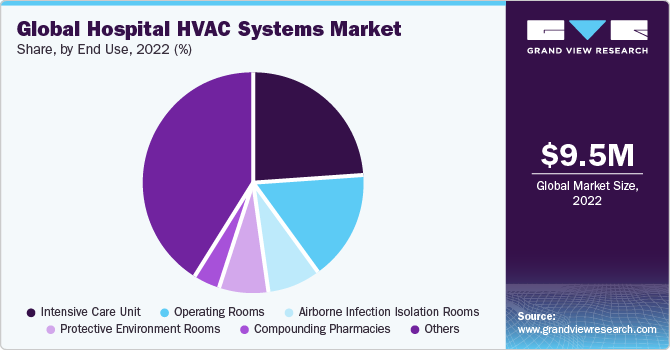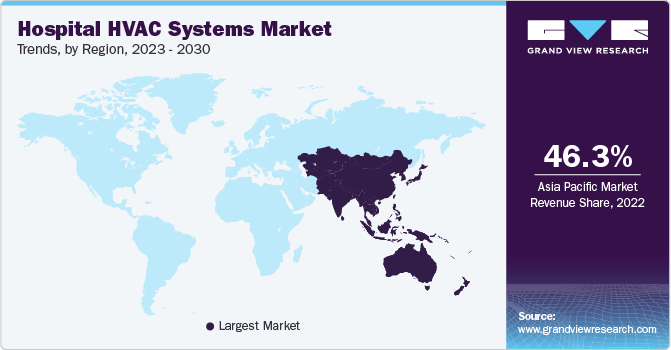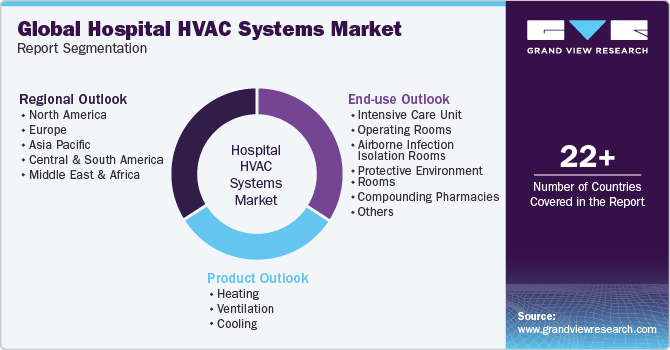- Home
- »
- Advanced Interior Materials
- »
-
Hospital HVAC Systems Market Size & Share Report, 2030GVR Report cover
![Hospital HVAC Systems Market Size, Share & Trends Report]()
Hospital HVAC Systems Market Size, Share & Trends Analysis Report By Product (Heating, Ventilation, Cooling), By End Use (Intensive Care Unit, Operating Rooms, Airborne Infection Isolation Rooms), By Region, And Segment Forecasts, 2023 - 2030
- Report ID: GVR-4-68038-133-7
- Number of Report Pages: 128
- Format: PDF, Horizon Databook
- Historical Range: 2018 - 2021
- Forecast Period: 2023 - 2030
- Industry: Advanced Materials
Hospital HVAC Systems Market Trends
The global hospital HVAC systems market size was valued at USD 9.55 billion in 2022 and is expected to grow at a compound annual growth rate (CAGR) of 7.2% from 2023 to 2030. Controlling variable environmental factors, such as temperature, humidity, airflow, and pressure is imperative to maintaining healthy indoor air in healthcare setups. Considering the vulnerable health condition of patients, it is crucial to control the indoor environment in hospitals. Thus, the need for maintaining the requisite temperature range to ensure the health and safety of patients along with other hospital personnel is driving demand for HVAC systems.

The above trend has urged manufacturers to shift toward the use of mild ingredients such as sulfate-free anionic surfactants, which are preferred over conventional products such as sodium lauryl ether. The growth of the hospital industry is anticipated to accelerate the demand for HVAC equipment in healthcare facilities. The aging population and increased prevalence of chronic diseases are the factors contributing to the rise in investments and the number of hospitals worldwide. According to the Government of India’s Department for Promotion of Industry and Internal Trade, the hospital industry in the country is expected to reach USD 132 billion by 2023 from USD 61.8 billion in 2017. Thus, the rise in the number of hospitals is likely to positively influence the demand for HVAC systems.
HVAC systems used in hospitals are designed as per the standards defined for a healthy environment necessary for the occupants. For instance, the American Society of Heating, Refrigerating, and Air Conditioning Engineers (ASHRAE) has defined standard temperature, pressure, humidity, and Air Change Rate (ACH) levels for individual rooms in any hospital. Moreover, HVAC provides additional functionalities, such as therapeutic conditioning and infection control in hospitals and other such healthcare facilities. Compliance with the pre-defined temperatures at healthcare facilities is expected to drive the demand for hospital HVAC systems.
The production of state-of-the-art energy-efficient products is anticipated to drive the demand for hospital HVAC systems in the near future. Use of the systems that operate on natural energy sources, such as solar power, helps reduce the cost associated with electricity. Moreover, these systems also reduce air pollution significantly as compared to conventional HVAC units. The advent of advanced products coupled with the paradigm shift in terms of the adoption of energy-efficient systems is expected to drive the market over the forecast period
There exists a need to replace aging systems with new HVAC systems, which is attributed to the growing emphasis on energy efficiency and emission control. Thus, refurbishment of aging infrastructure or an upgrade from old to new units is also anticipated to drive the product demand from hospitals over the forecast period.
The market for hospital HVAC systems is anticipated to be driven by increased demand for energy-efficient systems coupled with rising awareness of high comfort levels in hospitals. The continued rise in infrastructure and construction activities of commercial buildings is also anticipated to contribute to the hospital HVAC systems market growth.
Rising awareness regarding how the indoor environment can impact the way people think feel and act has triggered the demand for healthcare building HVAC systems. Similarly, the standards governing the temperature, pressure, and humidity in hospital rooms are further expected to propel the demand for hospital HVAC systems.
There exists a need to replace aging systems with upgraded/new HVAC systems, which is attributed to the growing emphasis on energy efficiency and emission control. The extensive use of HVAC systems in hospitals further increases the need to replace these systems frequently. Thus, refurbishment of aging infrastructure or an upgrade from old to new units is anticipated to drive the sale of HVAC systems over the forecast period.
The upward growth of real estate has a positive impact on the HVAC systems market, supported collectively by an increase in construction spending as well as a rise in building permits for the construction of residential, commercial, and industrial spaces. Installation charges are relatively much higher, although variable, depending on the unit type. For instance, the average price of the installation of a commercial rooftop air conditioner is almost equal to the price of the unit. Moreover, high prices may drive customers toward cheaper options that may not be as effective.
Several policies such as the American Society of Heating, Refrigerating, and Air Conditioning Engineers (ASHRAE) have defined standard temperature, pressure, humidity, and Air Change Rate (ACH) levels for individual rooms in any hospital. Moreover, HVAC provides additional functionalities, such as therapeutic conditioning and infection control in hospitals and other healthcare facilities. Compliance with the pre-defined temperatures at healthcare facilities is expected to drive the demand for hospital HVAC systems.
End Use Insights
The intensive care unit (ICU) segment accounted for the second largest revenue share of 24.0% in 2022. The critical health condition of patients admitted to the ICU unit demands a regulated and controlled temperature environment. Moreover, the average temperature in critical care rooms is lower than that of the other rooms to assist in the healing process.

The airborne infection isolation rooms segment is expected to grow at a CAGR of 5.6% over the forecast period. The rise in infectious diseases that spread through bacteria and viruses are primarily contributing to the rise in the number of isolation rooms in hospitals. Such rooms require special ventilation facilities and negative room pressure to control the spread of diseases.
Others segment held the largest market share of more than 40% in 2022 and is expected to register a CAGR exceeding 7.1% over the forecast period. Other rooms and wards in hospitals include waiting rooms, non-intensive care units, pathology labs, general wards, and numerous other rooms. The collective HVAC requirements in all these rooms are substantially higher than the aforementioned units. Thus, the segment is anticipated to continue to hold the maximum value share in the forthcoming years.
Product Insights
The cooling segment accounted for the largest revenue share of 55.2% in 2022. The use of air conditioning systems aids healthcare facilities in temperature regulation, controlling dampness that stimulates the spread of microorganisms, and maintaining good air quality essential for patient comfort and recovery. Thus, the imminent need to achieve the aforementioned benefits is expected to drive demand for cooling systems at healthcare facilities.
The heating segment is expected to grow at a CAGR of 6.6% during the forecast period. The demand for heating in hospitals is attributed to the requirement for high temperatures at certain hospital facilities, such as the burn units. The burn units maintain a high average room temperature to keep the patient’s core body temperature high for assisted healing of wounds.
Regional Insights
Asia Pacific dominated the market and accounted for the largest revenue share of 46.3% in 2022. The Asia Pacific is characterized by increasing expenditure on infrastructure development is expected to create demand for HVAC systems in the regional commercial sector, which is anticipated to contribute to the product demand for hospital HVAC systems. Most manufacturers are investing in green HVAC and building automation system technology to reduce carbon footprints and save energy. All these factors are expected to drive demand for HVAC systems across multiple segments including healthcare.

The demand for hospital HVAC systems in China is driven by an increased aging population, an increase in non-communicable diseases, expanding healthcare initiatives, and favorable government policies that encourage the use of energy-efficient equipment by giving subsidies and tax benefits.
North America is expected to grow at a CAGR of 6.7% during the forecast period. North America is characterized by high investment in the healthcare business in the United States and Canada, as well as rising building automation system technology to reduce carbon footprints and save energy along with the presence of major HVAC manufacturers are driving the market growth. In addition, government energy-efficiency incentives are expected to benefit HVAC contractors across the country.
The demand for hospital HVAC systems is driven by the rising construction industry, the availability of efficient and advanced systems, and extreme climatic conditions favoring the installation of HVAC in both residential and commercial buildings. In addition, the large presence of key manufacturers of hospital HVAC systems in this region propels the market for hospital HVAC systems.
Key Companies & Market Share Insights
Market players are increasingly investing in R&D in a bid to develop technologically advanced systems like IoT-enabled HVAC systems. For instance, in April 2020, Carrier Corporation introduced the OptiClean portable negative air machine, especially for hospitals treating patients with COVID-19. This innovative device effectively cleans and eliminates potentially virus-contaminated air within enclosed spaces. The machine employs high-efficiency particulate air (HEPA) filters and an advanced air management system to substantially reduce the presence of coronavirus and other contaminants in the air. Additionally, it utilizes flexible ducting to exhaust the filtered air.
Key Hospital HVAC Systems Companies:
- LG Electronics
- Lennox International Inc.
- Carrier Corporation
- Samsung Electronics Co., Ltd.
- Electrolux AB Corporation
- United Technologies Corporation
- Haier Inc.
- Havells India Ltd.
- Johnson Controls–Hitachi Air Conditioning
- Emerson Electric Co.
- Rheem Manufacturing Company
- Mitsubishi Electric Trane HVAC US LLC
Recent Developments
-
In June 2023, Mitsubishi Electric Trane HVAC US LLC, introduced the innovative Hybrid VRF. This advanced two-pipe VRF zoning system is ingeniously designed to utilize water as an alternative to refrigerant within an indoor environment. The Hybrid VRF system facilitates a heat exchange process between water and refrigerant, enabled by Mitsubishi Electric's patented Hybrid Branch Circuit Controller (HBC). As a result, Hybrid VRF offers heat recovery capabilities, allowing for simultaneous heating and cooling without refrigerant circulation within indoor piping.
-
In January 2023, Johnson Controls-Hitachi Air Conditioning launched the air365 Max, a cutting-edge product that prioritizes seamless energy efficiency, comfort, and user-friendly features. This end-to-end HVAC solution is tailored to meet the needs of HVAC professionals, building owners, and architects. Initially, selected models were available in the Middle East, South East Asia, and Latin America, starting in January 2023. Subsequently, the product will be made available in North America, Australia, New Zealand, Europe, and various other regions.
-
In September 2021, Rheem Manufacturing Company completed the acquisition of Friedrich Air Conditioning from Monomoy Capital Partners. The company's room air conditioning solutions cater to various applications, including residential homes, hotels, and multi-family buildings. Headquartered in San Antonio, Friedrich's manufacturing facilities are situated in Monterrey, Mexico, while distribution centers are strategically positioned in Texas and New Jersey.
Hospital HVAC Systems Market Report Scope
Report Attribute
Details
Market size value in 2023
USD 10.18 billion
Revenue forecast in 2030
USD 16.69 billion
Growth Rate
CAGR of 7.2% from 2023 to 2030
Base year for estimation
2022
Historical data
2018 - 2021
Forecast period
2023 - 2030
Report updated
November 2023
Quantitative units
Revenue in USD million/billion and CAGR from 2023 to 2030
Report coverage
Revenue forecast, company ranking, competitive landscape, growth factors, and trends
Segments covered
Product, end-use, region
Regional scope
North America; Europe; Asia Pacific; Central & South America; and MEA
Country scope
U.S.; Canada; Mexico; UK; Germany; France; Italy; Spain; Russia; China; Japan; India; South Korea; Malaysia; Indonesia; Australia; Thailand; Brazil; Argentina; Saudi Arabia; UAE; South Africa
Key companies profiled
LG Electronics; Lennox International Inc.; Carrier Corporation; Samsung Electronics Co., Ltd.; Electrolux AB Corporation; United Technologies Corporation; Haier Inc.; Havells India Ltd.; Johnson Controls–Hitachi Air Conditioning; Emerson Electric Co.; Rheem Manufacturing Company; Mitsubishi Electric Trane HVAC US LLC
Customization scope
Free report customization (equivalent up to 8 analyst’s working days) with purchase. Addition or alteration to country, regional & segment scope
Pricing and purchase options
Avail customized purchase options to meet your exact research needs. Explore purchase options
Global Hospital HVAC Systems Market Report Segmentation
This report forecasts revenue growth at global, regional, and country levels and provides an analysis of the latest industry trends in each of the sub-segments from 2018 to 2030. For this study, Grand View Research has segmented the global hospital HVAC systems market based on product, end-use, and region:

-
Product Outlook (Revenue, USD Million, 2018 - 2030)
-
Heating
-
Ventilation
-
Cooling
-
-
End Use Outlook (Revenue, USD Million, 2018 - 2030)
-
Intensive Care Unit (ICU)
-
Operating Rooms
-
Airborne Infection Isolation Rooms
-
Protective Environment Rooms
-
Compounding Pharmacies
-
Others
-
-
Regional Outlook (Revenue, USD Million, 2018 - 2030)
-
North America
-
U.S.
-
Canada
-
Mexico
-
-
Europe
-
UK
-
Germany
-
France
-
Italy
-
Spain
-
Russia
-
-
Asia Pacific
-
China
-
Japan
-
India
-
South Korea
-
Malaysia
-
Indonesia
-
Australia
-
Thailand
-
-
Central & South America
-
Brazil
-
Argentina
-
-
Middle East and Africa
-
Saudi Arabia
-
UAE
-
South Africa
-
-
Frequently Asked Questions About This Report
b. The global hospital HVAC systems market size was estimated at USD 9.55 billion in 2022 and is expected to be USD 10.18 billion in 2023.
b. The global hospital HVAC systems market, in terms of revenue, is expected to grow at a compound annual growth rate of 7.2% from 2023 to 2030 to reach USD 16.69 billion by 2030.
b. Asia Pacific dominated the market in 2022 by accounting for a share of 46.3% of the market. The region is characterized by increasing expenditure on infrastructure development, which is expected to create demand for HVAC systems in the regional commercial sector, which is anticipated to contribute to the product demand for hospital HVAC systems.
b. Some of the key players operating in the hospital HVAC systems market include LG Electronics, Lennox International Inc., Carrier Corporation, Samsung Electronics Co., Ltd., Electrolux AB Corporation, United Technologies Corporation, Haier Inc., Havells India Ltd., Hitachi Ltd., Emerson Electric Co., Rheem Manufacturing Company, Mitsubishi Electric, Daikin Industries, Ltd., Johnson Controls International plc, and Trane, Inc.
b. Controlling variable environmental factors, such as temperature, humidity, air flow, and pressure are imperative to maintaining a healthy indoor air at healthcare setups. Considering the vulnerable health condition of patients, it is crucial to control the indoor environment in hospitals. Thus, the need for maintaining the requisite temperature range to ensure the health and safety of patients along with other hospital personnel is driving demand for HVAC systems.
Share this report with your colleague or friend.
![gvr icn]()
NEED A CUSTOM REPORT?
We can customize every report - free of charge - including purchasing stand-alone sections or country-level reports, as well as offer affordable discounts for start-ups & universities. Contact us now
![Certified Icon]()
We are GDPR and CCPA compliant! Your transaction & personal information is safe and secure. For more details, please read our privacy policy.
We are committed towards customer satisfaction, and quality service.
"The quality of research they have done for us has been excellent."





